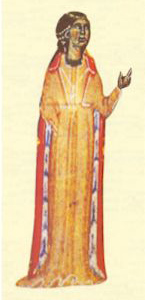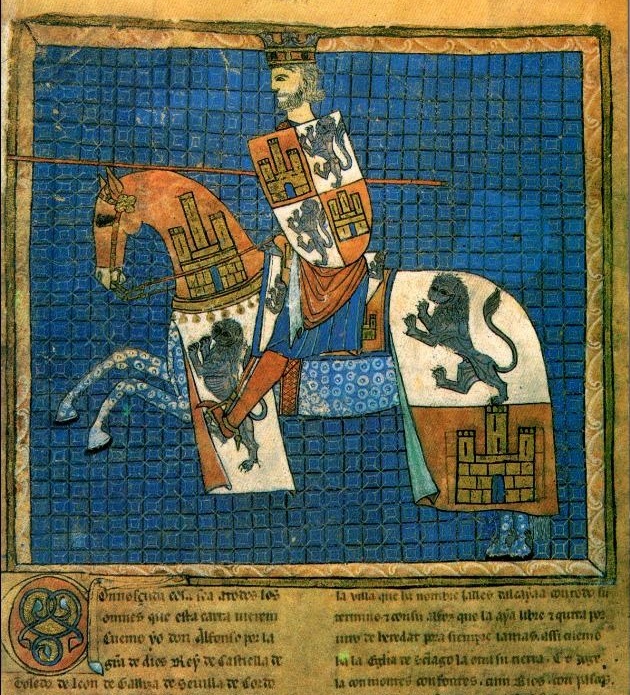|
María Pérez Balteira
María Pérez (), called La Balteira ("the Balteira"), was a Galician trobairitz and soldadeira. Life María Pérez was a composer and singer who wrote sacred plainsong, performed in the courts of Europe, and was somewhat of an adventurer.Commire, ed. 2007. p. 1,498. She was popular at the courts of Ferdinand III of Castile and Alfonso X of Castile, and the latter dedicated a song to her. References Citations Bibliography * Abelleira, Fernando Magán (1996). ''Lírica profana galego-potuguesa''Vol. 1 Galicia: Centro Ramón Piñeiro. pp. 39, 149, 421. * Abelleira, Fernando Magán (2007)"María Pérez, Balteira, ou, María Balteira na literatura medieval. Escolma de textos" Consello da Cultura Galega, Comisión de Igualdade. pp. 1–13. * Alvar, Carlos (1985)"María Pérez, Balteira" ''Aragonese Philology Archive'', no. 36. pp. 11–40. * Amil, Iván Fernández (22 November 2020)"María Pérez la Balteira, la gallega que conquistó Jerusalén y la Corte de Alfonso ... [...More Info...] [...Related Items...] OR: [Wikipedia] [Google] [Baidu] |
Cancioneiro Da Ajuda Folio 21r
A chansonnier (, , Galician and , or ''canzoniéro'', ) is a manuscript or printed book which contains a collection of chansons, or polyphonic and monophonic settings of songs, hence literally " song-books"; however, some manuscripts are called chansonniers even though they preserve the text but not the music, for example, the Cancioneiro da Vaticana and Cancioneiro da Biblioteca Nacional, which contain the bulk of Galician-Portuguese lyrics. The most important chansonniers contain lyrics, poems and songs of the troubadours and trouvères used in the medieval music. Prior to 1420, many song-books contained both sacred and secular music, one exception being those containing the work of Guillaume de Machaut. Around 1420, sacred and secular music was segregated into separate sources, with large choirbooks containing sacred music, and smaller chansonniers for more private use by the privileged. Chansonniers were compiled primarily in France, but also in Italy, Germany and in the Ibe ... [...More Info...] [...Related Items...] OR: [Wikipedia] [Google] [Baidu] |
Galicians
Galicians ( or ''pobo galego''; ) are an ethnic group primarily residing in Galicia, northwest Iberian Peninsula. Historical emigration resulted in populations in other parts of Spain, Europe, and the Americas. Galicians possess distinct customs, culture, language, music, dance, sports, art, cuisine, and mythology. Galician, a Romance language derived from the Latin of ancient Roman Gallaecia, is their native language and a primary cultural expression. It shares a common origin with Portuguese, exhibiting 85% intelligibility, and similarities with other Iberian Romance languages like Asturian and Spanish. They are closely related to the Portuguese people. Two Romance languages are widely spoken and official in Galicia: the native Galician and Spanish. Etymology The ethnonym of the Galicians (''galegos'') derives directly from the Latin '' Gallaeci'' or ''Callaeci'', itself an adaptation of the name of a local Celtic tribe known to the Greeks as Καλλαϊκoί (''Ka ... [...More Info...] [...Related Items...] OR: [Wikipedia] [Google] [Baidu] |
Trobairitz
The ''trobairitz'' () were Occitania, Occitan female troubadours of the 12th and 13th centuries, active from around 1170 to approximately 1260. ''Trobairitz'' is both singular and plural. The word ''trobairitz'' is first attested in the 13th-century romance (heroic literature), romance ''Romance of Flamenca, Flamenca''. It comes from the Provençal word ''trobar'', the literal meaning of which is "to find", and the technical meaning of which is "to compose". The word ''trobairitz'' is used very rarely in medieval Occitan language, Occitan, as it does not occur in lyrical poetry, grammatical treatises or in the Vida (Occitan literary form), biographies (''vidas'') of the ''trobairitz'' or troubadours. It does occur in the treatise ''Doctrina d'acort'' by Terramagnino da Pisa, written between 1282 and 1296. He uses it as an example of a word the plural and singular of which are the same..: "which are correctly used only with flexional endings in all numbers ... ''trobayritz''" ('' ... [...More Info...] [...Related Items...] OR: [Wikipedia] [Google] [Baidu] |
Soldadeira
The Galician-Portuguese term soldadeira, and the Spanish term soldadera, meant a woman of questionable morality who danced and performed gymnastic exercises during the performance of playwrights or troubadours. They have been referred to as "spiritual heirs" of the '' puellae gaditanae'' mentioned by Martial and Juvenal.Aletti 1980, p. 5. See also * Galician-Portuguese lyric * María Pérez Balteira * Flamenco Notes References * Aletti, Adelina (1980). Gli abbracci feriti: poetesse portoghesi di oggi'. Milan: G. Feltrinelli. p. 5. * Dronke, Peter (2007). Forms and Imaginings: From Antiquity to the Fifteenth Century'. Edizioni di Storia e Letteratura. p. 334. * Filios, Denise Keyes (1997). Women Out of Bounds: Soldadeiras, Panaderas, and Serranas in the Poetry of Medieval Spain'. Thesis (Ph. D. in Comparative Literature). University of California, Berkeley. pp. 13, 22, 68. "Soldadeira" ''Dicionario RAG''. Real Academia Galega The Royal Galician Academy (, RAG) is ... [...More Info...] [...Related Items...] OR: [Wikipedia] [Google] [Baidu] |
Ferdinand III Of Castile
Ferdinand III (; 1199/120130 May 1252), called the Saint (''el Santo''), was King of Castile from 1217 and King of León from 1230 as well as King of Galicia from 1231. He was the son of Alfonso IX of León and Berengaria of Castile. Through his second marriage he was also Count of Aumale. Ferdinand III was one of the most successful kings of Castile, securing not only the permanent union of the crowns of Castile and León, but also masterminding the most expansive southward territorial expansion campaign yet in the Guadalquivir Valley, in which Islamic rule was in disarray in the wake of the defeat of the Almohad caliphate at the Battle of Las Navas de Tolosa. His repeated and decisive victories against the Islamic Caliphate earned him the title Athleta Christi, meaning 'Champion of Christ', which was conferred upon him by Pope Gregory IX. By military and diplomatic efforts, Ferdinand greatly expanded the dominions of Castile by annexing the Guadalquivir, crown of Guadalquivir ... [...More Info...] [...Related Items...] OR: [Wikipedia] [Google] [Baidu] |
Alfonso X Of Castile
Alfonso X (also known as the Wise, ; 23 November 1221 – 4 April 1284) was King of Castile, Kingdom of León, León and Kingdom of Galicia, Galicia from 1 June 1252 until his death in 1284. During the April 1257 Imperial election, election of 1257, a dissident faction chose him to be king of Germany on 1 April. He renounced his claim to Germany in 1275, and in creating an alliance with the Kingdom of England in 1254, his claim on the Duchy of Gascony as well. Alfonso's scientific interests—he is sometimes nicknamed the Astrologer (''el Astrólogo'')—led him to sponsor the creation of the Alfonsine tables, and the Alphonsus (crater), Alphonsus crater on the Moon is named after him. He also sponsored the work of historians who, for the first time since Isidore of Seville in , placed Spain in the context of world history. As a lawmaker he introduced the first vernacular law code in Castile, the ''Siete Partidas''. He created the Mesta, an association of sheep farmers in the cen ... [...More Info...] [...Related Items...] OR: [Wikipedia] [Google] [Baidu] |
El Español
''El Español'' is a Spanish online newspaper that started in 2015. It has its headquarters in Avenida de Burgos, 16D, 7º, Madrid, Comunidad de Madrid. As of April 2025, it has the largest digital reach among all newspapers in Spain, averaging more than 3 millions views per day and about 20 million unique users per month. History In 2014, Pedro J. Ramírez was dismissed as the director from the newspaper '' El Mundo''. Alongside his daughter María Ramírez Fernández, he founded ''El Español''. The website was opened on 11 January 2015. On 10 January 2015, it raised € from 5,624 people in two months through crowdfunding. On 10 April 2015, it transformed into a public limited company (Sociedad Anónima), with a share capital A corporation's share capital, commonly referred to as capital stock in the United States, is the portion of a corporation's equity that has been derived by the issue of shares in the corporation to a shareholder, usually for cash. ''Share . ... [...More Info...] [...Related Items...] OR: [Wikipedia] [Google] [Baidu] |
A Biographical Encyclopedia
A, or a, is the first letter and the first vowel letter of the Latin alphabet, used in the modern English alphabet, and others worldwide. Its name in English is '' a'' (pronounced ), plural ''aes''. It is similar in shape to the Ancient Greek letter alpha, from which it derives. The uppercase version consists of the two slanting sides of a triangle, crossed in the middle by a horizontal bar. The lowercase version is often written in one of two forms: the double-storey and single-storey . The latter is commonly used in handwriting and fonts based on it, especially fonts intended to be read by children, and is also found in italic type. In English, '' a'' is the indefinite article, with the alternative form ''an''. Name In English, the name of the letter is the ''long A'' sound, pronounced . Its name in most other languages matches the letter's pronunciation in open syllables. History The earliest known ancestor of A is ''aleph''—the first letter of the Phoenician ... [...More Info...] [...Related Items...] OR: [Wikipedia] [Google] [Baidu] |
Trobairitz
The ''trobairitz'' () were Occitania, Occitan female troubadours of the 12th and 13th centuries, active from around 1170 to approximately 1260. ''Trobairitz'' is both singular and plural. The word ''trobairitz'' is first attested in the 13th-century romance (heroic literature), romance ''Romance of Flamenca, Flamenca''. It comes from the Provençal word ''trobar'', the literal meaning of which is "to find", and the technical meaning of which is "to compose". The word ''trobairitz'' is used very rarely in medieval Occitan language, Occitan, as it does not occur in lyrical poetry, grammatical treatises or in the Vida (Occitan literary form), biographies (''vidas'') of the ''trobairitz'' or troubadours. It does occur in the treatise ''Doctrina d'acort'' by Terramagnino da Pisa, written between 1282 and 1296. He uses it as an example of a word the plural and singular of which are the same..: "which are correctly used only with flexional endings in all numbers ... ''trobayritz''" ('' ... [...More Info...] [...Related Items...] OR: [Wikipedia] [Google] [Baidu] |
13th-century Galician People
The 13th century was the century which lasted from January 1, 1201 (represented by the Roman numerals MCCI) through December 31, 1300 (MCCC) in accordance with the Julian calendar. The Mongol Empire was founded by Genghis Khan, which stretched from Eastern Asia to Eastern Europe. The conquests of Hulagu Khan and other Mongol invasions changed the course of the Muslim world, most notably the Siege of Baghdad (1258) and the destruction of the House of Wisdom. Other Muslim powers such as the Mali Empire and Delhi Sultanate conquered large parts of West Africa and the Indian subcontinent, while Buddhism witnessed a decline through the conquest led by Bakhtiyar Khilji. The earliest Islamic states in Southeast Asia formed during this century, most notably Samudera Pasai Sultanate, Samudera Pasai. The Kingdoms of Sukhothai Kingdom, Sukhothai and Hanthawaddy Kingdom, Hanthawaddy would emerge and go on to dominate their surrounding territories. Europe entered the apex of the High Middle ... [...More Info...] [...Related Items...] OR: [Wikipedia] [Google] [Baidu] |



